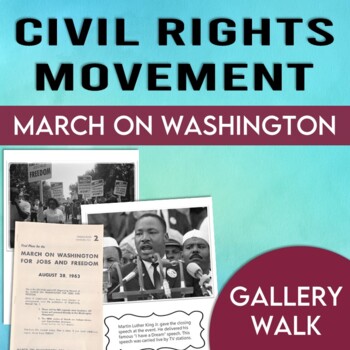Civil Rights Movement: March on Washington Gallery Walk Activity
- PDF
What educators are saying
Description
In this Civil Rights Movement activity, your students will become historians as they analyze the official March on Washington organizing manual that was published prior to the demonstration. Then they will take a gallery walk to analyze historical images from the demonstration. Students will answer critical thinking questions throughout the activity and complete a final reflection. This resource is set up in an easy-to-print format to save you time.
Primary Source Analysis:
There is no better way to understand the past than to analyze primary sources. Your students will become historians! They will hold, flip through, read, and analyze the official March on Washington For Jobs and Freedom organizing manual from 1963. This manual was given out prior to the event. The pamphlet laid out the details of the event, the purpose and intention behind the demonstration, and more. Your students will analyze the document using the provided analysis questions.
Gallery Walk:
A gallery walk is a classroom-based active learning strategy where students silently move throughout the room to view images and captions related to a particular topic or concept (in this case, the March on Washington). Students record their reflections using the provided graphic organizers. Images are placed on the walls around the classroom. This resource contains over 30 photographs and images from the March on Washington each containing a helpful description.
Student Response Booklet:
This resource contains an easy-to-print student response booklet. Just print and staple into a booklet. The booklet contains graphic organizers with questions to help guide students through making an interpretation of the document. Students will also complete the provided graphic organizer as they make their way through the gallery walk. This is a great way to keep students accountable as they view the images.
Glossary of Terms:
The booklet contains a page with helpful terms. Students are encouraged to reference the glossary for terms that are unfamiliar as they analyze the March on Washington Manual.
Comprehension Assessments:
Two assessment options are included. Choose between multiple-choice & true/false, or short answer questions. These assessments can be completed after the analysis activity.
Final Reflection:
It is critical that our students understand that they can take action today. A reflection sheet is included to encourage students to think about ways they can get involved in special interests today.
Answer Keys & Teacher Tips:
This resource contains answer keys for the analysis questions. Details are also provided for setting up an effective gallery walk in the classroom, including photos from my own classroom gallery walk.
Thank you!
Michelle McDonald, B.A.E.
Social Studies Education, K-12
Elementary Education K-8
* * * * * * * * * * * * * * * * * * * * * * * * * * * * * * * * * * * * * * * * * * * * * * * * * * * * * *
Connect with Me:
Instagram @mrsmichellemcdonald
Facebook: Michelle McDonald-Strategic Educational Services
Blog: StrategicEducationalServices.com
* * * * * * * * * * * * * * * * * * * * * * * * * * * * * * * * * * * * * * * * * * * * * * * * * * * * * *
Follow me on TpT to be the first to learn about new products, sales, and discounts. Follow Michelle McDonald





